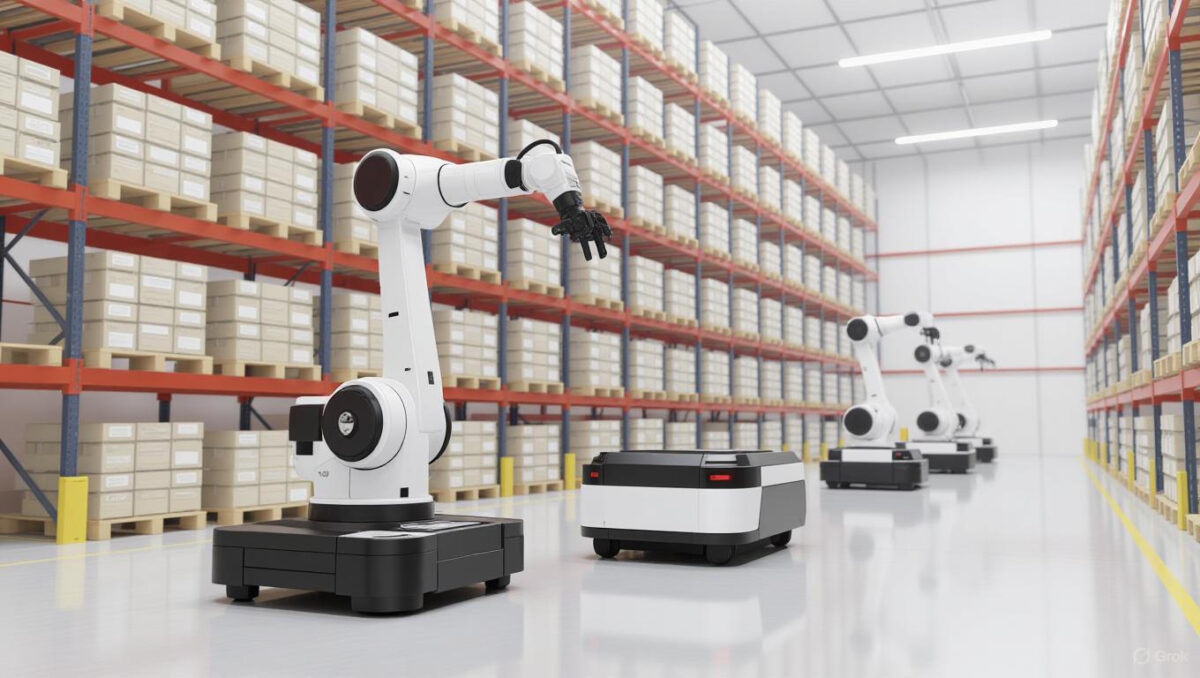The Future of Automated Warehouse Robots: Revolutionizing Logistics

Introduction
The logistics industry is undergoing a dramatic transformation, and at the heart of this evolution are automated warehouse robots. These advanced machines are increasingly becoming integral to modern warehouses, revolutionizing how businesses manage their supply chains, handle inventory, and fulfill orders. With the growing demand for speed, accuracy, and efficiency in logistics, companies are turning to warehouse robotics to meet these challenges.
In this blog, we will explore how robots in warehouses are reshaping logistics operations, the role of warehouse robots companies, and how industry leaders like Amazon are leveraging robotics to enhance their warehouse operations. We’ll also look at the benefits of automated warehouse robots and how they are improving productivity and reducing costs in logistics.
What Are Automated Warehouse Robots?
1. Defining Automated Warehouse Robots
Automated warehouse robots are machines designed to perform tasks typically done by humans in a warehouse or distribution center. These tasks can include picking, sorting, packing, and transporting goods within the warehouse. Unlike traditional manual labor, these robots operate autonomously, utilizing advanced sensors, AI algorithms, and machine learning to navigate and carry out tasks with precision.
The key feature of automated warehouse robots is their ability to operate without direct human intervention, thereby increasing efficiency and productivity while reducing the likelihood of human error. These robots are also often designed to work in collaboration with human workers, allowing for a more integrated warehouse system.
Benefits:
- Reduced labor costs by automating routine tasks.
- Increased productivity through 24/7 operation.
- Higher accuracy in inventory management and order fulfillment.
The Role of Warehouse Robotics in Logistics
2. How Warehouse Robotics is Transforming the Logistics Industry
Warehouse robotics is not just a trend; it’s a significant shift in how warehouses and distribution centers operate. From robotic arms for sorting and packing to autonomous mobile robots (AMRs) for transporting goods, warehouse robots are improving the speed and accuracy of logistics operations.
These robots can work in environments that might be challenging for human workers, such as high-density storage areas, high-risk tasks, or hazardous conditions. By taking over routine and physically demanding jobs, robots allow human workers to focus on more complex tasks, ultimately leading to a more efficient and safer warehouse environment.
Benefits:
- Faster order fulfillment with increased throughput.
- Improved safety by reducing human exposure to hazardous conditions.
- Optimized space utilization through robot-driven storage systems.
Amazon Robots in the Warehouse: A Leading Example
3. How Amazon is Using Robotics to Improve Warehouse Efficiency
Amazon, a leader in the e-commerce industry, has embraced warehouse robotics to streamline its logistics operations. With its vast network of fulfillment centers, Amazon has incorporated robotic systems into nearly every aspect of its operations, from inventory management to order fulfillment.
One of the most famous examples of Amazon’s warehouse robotics is its Kiva robots, now known as Amazon Robotics. These robots are responsible for automating the picking and packing processes, moving goods to human workers who then prepare them for shipment. Amazon’s robotics system allows for faster processing times, more efficient use of space, and fewer errors in order fulfillment.
In addition to Kiva robots, Amazon uses other advanced robotic systems such as autonomous mobile robots (AMRs), robotic arms, and AI-driven sorting systems, all working together to create a seamless, highly efficient warehouse operation.
Benefits:
- Fast order fulfillment with robot-driven automation.
- Scalable operations that grow with increasing demand.
- Improved warehouse productivity with the integration of robots.
Robots in Warehouse Operations: Enhancing Efficiency and Reducing Costs
4. How Robots Improve Operational Efficiency in Warehouses
Robots in warehouses play a crucial role in improving operational efficiency. Automated systems handle repetitive tasks such as order picking, sorting, and inventory management, all of which are essential to warehouse operations. By allowing robots to perform these tasks, human workers can focus on more value-added activities, such as quality control and customer service.
The robotic warehouse systems are designed to work around the clock, reducing the dependency on human labor, increasing operational capacity, and speeding up order processing times. Moreover, these systems can communicate with each other to coordinate tasks in real time, ensuring smooth operations and quick adaptation to changing demand.
Benefits:
- Faster cycle times for inventory handling and order fulfillment.
- Optimized workflows with robots working alongside humans.
- Cost savings in labor and operational expenses.
The Future of Warehouse Robotics: Trends and Innovations
5. The Evolution of Robotic Systems in Warehouses
As technology advances, the future of automated warehouse robots looks even brighter. The next generation of warehouse robots will include smarter AI, better machine learning capabilities, and advanced sensor technologies. These robots will be able to work even more autonomously, integrating seamlessly into the supply chain and warehouse management systems.
Some of the emerging trends in warehouse robotics include:
- AI-powered robots: Robots that use AI to make real-time decisions and adapt to changes in the warehouse environment.
- Collaborative robots (cobots): Robots designed to work alongside humans, enhancing efficiency and reducing the risk of accidents.
- Advanced sorting robots: Robots that can handle a wide variety of products, including irregularly shaped or fragile items.
With these advancements, the role of robots in warehouses will continue to expand, leading to more efficient, cost-effective, and innovative warehouse operations.
Benefits:
- Continuous improvement of robotic capabilities.
- Greater flexibility in handling diverse tasks.
- Enhanced collaboration between humans and robots.
The Impact of Warehouse Robots on the Future of Logistics
6. Warehouse Robots: The Backbone of Future Logistics Networks
Automated warehouse robots are rapidly becoming the backbone of modern logistics networks. As e-commerce and supply chain demands continue to grow, companies must adapt to new technologies to remain competitive. Robotic warehouse systems are helping businesses meet these demands by improving speed, accuracy, and scalability.
The integration of robots into warehouses is not just about replacing human labor but enhancing the entire logistics ecosystem. Warehouse robots enable companies to process more orders in less time, reduce operational costs, and deliver goods faster to customers.
Benefits:
- Increased operational agility in logistics networks.
- Cost-efficient operations through automation.
- Enhanced customer satisfaction with faster deliveries.
Conclusion
The rise of automated warehouse robots marks a new chapter in the logistics and supply chain industries. With the ability to streamline processes, reduce costs, and improve efficiency, robots in warehouses are revolutionizing how companies handle inventory and fulfill orders. Companies like Amazon are leading the charge with robotic warehouse systems, and as technology continues to evolve, the role of robots will only become more critical in shaping the future of logistics.
By embracing warehouse robotics, businesses can increase productivity, optimize workflows, and position themselves for success in an increasingly competitive market. As automation continues to play a larger role in warehouses, the potential for growth in automated warehouse robots is virtually limitless.
Embrace the Future of Warehouse Robotics Today
Interested in incorporating automated warehouse robots into your operations? Subscribe to our newsletter for the latest insights on warehouse robotics, AI-driven automation, and how robotic systems can improve your logistics operations. Or download our free guide to learn how to optimize your warehouse with robotic systems and warehouse automation.
